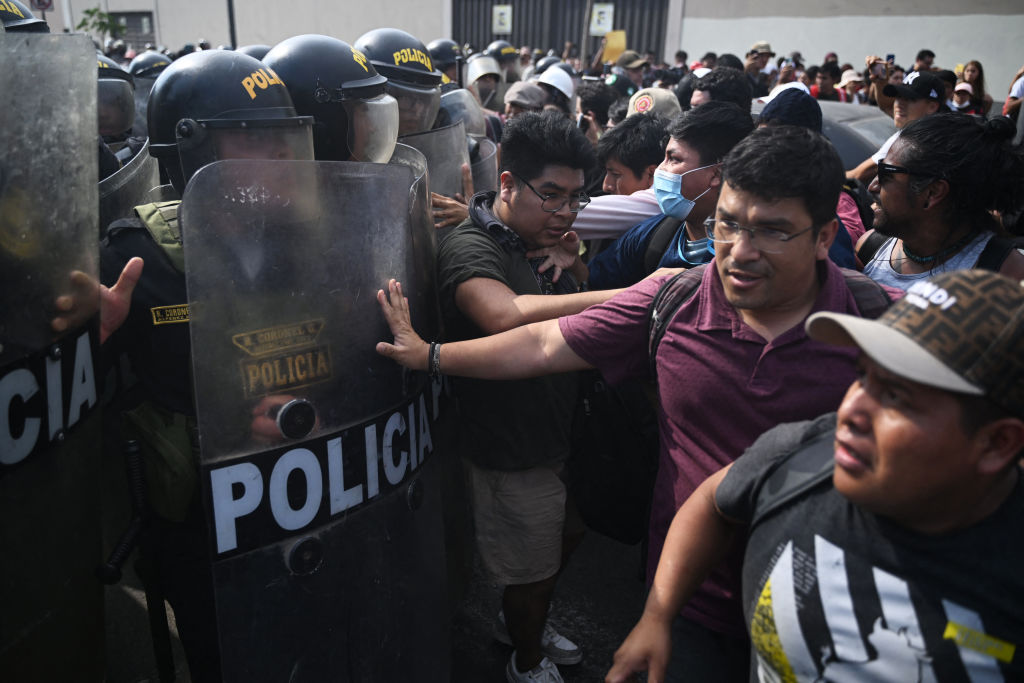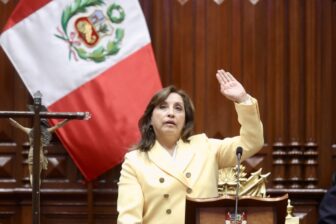LIMA — Social upheaval is not subsiding in Peru, increasing the risk that President Dina Boluarte may be forced to resign and replaced by the head of Congress with a mandate to call for early elections. A tragic death toll keeps mounting while there is no certainty that elections will restore stability. Although the economy has endured, political instability has undermined investor confidence, with prospects looking uncertain. Former President Pedro Castillo’s attempts to avoid being impeached by Congress culminated in his failed coup attempt—triggering the crisis. Social unrest was hardly surprising after 16 months of an incompetent and improvised government, perhaps one of the worst in Peru’s last 30 years.
However, the magnitude of turmoil and vandalism has been fueled by a deliberate political strategy, one, according to intelligence reports, supported by foreign governments (including Bolivia, Cuba and Venezuela) and an array of radical movements (including drug traffickers, illegal miners, Shining Path supporters and teacher trade unions) aiming to achieve political objectives such as immediate elections, the closure of Congress and convoking a Constitutional Assembly. The latter represents leftist politicians’ long-standing goal to scrap Alberto Fujimori’s 1993 Constitution. Although responsible for Peru’s economic transformation and impressive poverty reduction, the constitutional legal framework is blamed for persistent inequality and is a reminder of autocratic rule during the 1990s. The period’s legacy continues alienating a significant number of Peruvians.
In a very polarized and fragmented country with fragile institutions and disenfranchised citizens, Peru has become one of the most unstable countries in Latin America. During the past six years, the Andean nation has had unprecedented political instability with six presidents, three congresses, 15 prime ministers, and over 250 ministers being reshuffled. According to a global survey conducted by Ipsos, 69% of Peruvians agree that traditional parties and politicians don’t care about ordinary people, the highest level of citizen disaffection in the region (and third in the world after Romania and Turkey).
Subscribe to the Americas Quarterly Podcast on Apple, Spotify, Google and Soundcloud
Governance crises have become more frequent since the 2016 election, and ever since, no government has garnered sufficient congressional support to complete its mandate. Moreover, most living Peruvian former presidents are facing corruption charges or have been imprisoned. According to the Vanderbilt University LAPOP poll, Peru has the highest perception of corruption in Latin America. A clientelist political system and an ineffective and opaque public sector have severely strained trust in public institutions. All these issues, along with a poorly managed pandemic compounded by a combined record of having the highest per capita death toll and worst economic recession in the world, explain the social implosion in Peru. In sum, social legitimacy remains largely elusive, and the country is stuck in a bad equilibrium.
The main challenge is to restore political and social stability to recover progress in a country once considered an economic miracle. This is a difficult task given external downside risks. The base scenario is one in which the external environment will not boost economic activity. In fact, 60% of Peruvian GDP growth variability hinges upon external variables. A global slowdown and persistent geopolitical risks will limit domestic growth. Despite strong terms of trade (due to high copper prices), badly managed social conflicts around mining projects have negatively affected competitiveness and undermined investor confidence. Furthermore, social violence and vandalism are generating substantial economic losses, which may cause a recession. Tourism has virtually halted due to airport closures and road blockades, and shortages are pumping up fuel and food prices in a context where inflation remains well above the Central Bank’s target.
The evolution of domestic demand depends on the performance of investment and consumption. Public investment is expected to plummet, as is the case every four years after regional and local elected officials begin their term in office. Although private consumption largely sustained economic activity last year, spending has been heterogeneous by sector. Despite ongoing fiscal stimulus policies being pursued by Peru’s Finance Ministry, private consumption will be subdued due to weak labor markets, persistent inflation, and tightening consumer credit. GDP growth forecasts are being rapidly reduced, and higher poverty is expected. Strong macroeconomic fundamentals are insufficient to improve prospects, given the high uncertainty about upcoming elections amid social instability.
It is evident that persistent social gaps are a breeding ground for popular discontent. Changing this reality demands urgent action to close gaps in essential services quickly. Failing to do so will continue to boost support for disruptive regime changes. Having a more functional state that adopts public policies that respond more to the needs of citizens, guaranteeing that rule of law is respected and maintaining an enabling environment for private sector job creation are the only guarantees to restore social peace.
Ideologically driven objectives to draft a new constitution that favors statist policies may aggravate frustration further, as unfulfilled expectations will certainly exacerbate social tensions. Addressing structural problems entails building a more accountable political system and more resilient institutions. This, in turn, requires strong leadership that remains elusive today. Accelerating elections and posing referendums to disgruntled citizens will not guarantee better outcomes. Learning from past mistakes and identifying a common agenda in a highly polarized society are indispensable steps. Understanding this complex reality is difficult, but a widely accepted conclusion is that Peru is at a crossroads.
—
Castilla is an economist. He served as finance minister (2011-14) under President Ollanta Humala and as Peru’s ambassador to the U.S.








